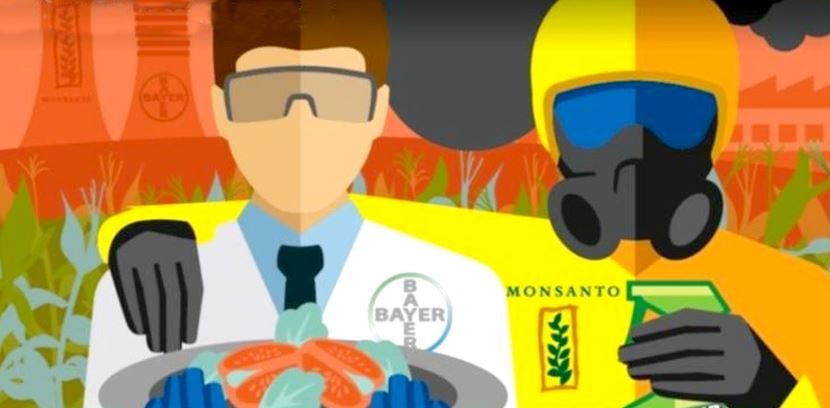Etofenprox — toxicity, side effects, diseases and environmental impacts
12/02/2017 / By Rita Winters

Etofenprox is a synthetic pyrethoid ether insecticide used against strains of rice green leafhopper and planthoppers that are resistant to organophosphorus or carbamate insecticides, owing to its pyrethroid-like activity. It is formulated as a wettable powder or emulsifiable concentrate. Other uses of etofenprox include outdoor and indoor mosquitocide foggers, crack and crevice spot treatment, as well as dog and cat flea treatment. Mitsui Chemicals Agro Inc., a Japanese chemical company, is the main manufacturer of the toxic chemical. Specific target insect species include Lepidoptera, Hemiptera, Coleoptera, Diptera, Thysanoptera, and Hymenoptera.
As a veterinary substance, etofenprox is used to rid pets of unwanted insects like fleas. It may be in the form of pet shampoos, soaps or sprays. Pets that have damaged skin may be prone to etofenprox poisoning, and may cause adverse biochemical reactions. There have been reports of overdosed dogs from products containing the toxic chemical. As compared to dogs, cats are more susceptible to poisoning due to their deficiency in glucuronidase, the enzyme responsible for breaking down synthetic pyrethroids. It is not used on livestock and in human medicines. There is no known antidote for etofenprox poisoning, and must not be ingested at all costs.
Other names and synonyms of etofenprox include: 2-(4-ethoxyphenyl)-2-methylpropyl 3-henoxybenzyl ether (IUPAC); 1-[[2-(4-ethoxyphenyl)-2-methylpropoxy]methyl]-3-phenoxybenzene (CA); CAS-80844-07-1; MTI-500; Zenivex; and Trebon.
List of known side effects
Etofenprox poisoning may cause irritation to the skin and eyes, irritability to sound or touch, abnormal facial sensations, and sensations of prickling, tingling or creeping on skin. Side effects also include headaches, dizziness, nausea, vomiting, diarrhea, excessive salivation, fatigue. Severe cases may include symptoms such as fluid in the lungs, muscle twitching and seizures.
It causes mortality and behavior modification in crustaceans, fishes, insects and zooplankton. It is highly toxic to environment-beneficial honey bees.
In human observations of exposure to the chemical (occupational exposure), findings show that 21 operators engaged in the production of the chemical did not have any compound-related effects nor subjective complaints. There are no studies of etofenprox poisoning in humans as of today.
Body systems affected by etofenprox
This chemical may cause endocrine system disruption and is likely carcinogenic. It targets the liver, thyroid gland, kidneys and hematopoietic system, or the bone marrow and lymph nodes.
Items that may contain etofenprox
Food items that may have etofenprox traces include apples, cabbages, Chinese cabbage, citrus, cucumber, eggplant, grapes, mandarin, olives, onions, oranges, peas, peaches, pears, persimmons, pome fruits, potatoes, Japanese radish, rapeseed fruit, rice, soya beans, sugar beets, tea, tomatoes and wheat.
Places that are fogged with mosquitocide products are also inhalation hazards and must be avoided. Pets and other animals treated for fleas with etofenprox-based chemicals may have traces of the chemical on their fur. Commercial agricultural farms may be a high risk for exposure to etofenprox.
How to avoid etofenprox
To reduce exposure to etofenprox, avoid areas that are sprayed – notices can be found on newspapers, websites, automated telephone messages, and distributions from local government units. Cover or bring outdoor furniture and pet accessories inside the house if spraying is near your home. Stay away from chemical storage areas and equipment used to apply etofenprox. Whenever possible, remain indoors during the fogging.
If etofenprox exposure on skin happens, wash the affected area thoroughly with soap and water. Flush eyes with water if it is contaminated by the chemical. In case of inhalation, move to a clear area with fresh air. For ingestion, immediately deliver victim to the nearest emergency department. For all cases mentioned, contact medical services as soon as possible.
Where to learn more
- Asbestos & Other Environmental Risks That Cause Cancer
- Poison.news
- Chemicals.news
- Pesticides.news
- Toxins.news
Summary
Etofenprox is an chemical insecticide used on many food crops.
Etofenprox is a toxic chemical that may affect the liver, thyroid gland, kidneys and the hematopoietic system.
Etofenprox is likely carcinogenic – it may increase the likelihood of cancer.
Sources include:
Tagged Under: etofenprox




















